Black and White Photography Portraits
When delving into the captivating world of black and white photography portraits, one is immediately struck by the timeless elegance and emotion these images convey. The absence of color allows the viewer to focus solely on the subject’s expressions, textures, and composition, creating a powerful visual impact.
Capturing a portrait in black and white requires a keen eye for detail and an understanding of how light interacts with shadow to sculpt a face. Each wrinkle, freckle, or strand of hair takes on new significance when color is removed from the equation. It’s about distilling the essence of a person into shades of gray, highlighting their character and inner beauty.
Black and white photography portraits have a rich history dating back to the early days of photography when monochrome images were the norm. Even in today’s era of advanced digital technology, this classic approach remains popular among photographers looking to create striking, soulful portraits that stand the test of time.
The Timeless Appeal of Black and White Photography Portraits
Black and white photography portraits have stood the test of time, captivating viewers with their classic elegance and timeless charm. When colors are stripped away, the focus shifts to the raw emotions and intricate details captured in each image. This simplicity allows the subject’s expressions and features to shine through without distraction.
In a world inundated with vibrant colors, black and white portraits offer a refreshing departure that evokes a sense of nostalgia and sophistication. The monochromatic palette adds a layer of depth and drama to the photographs, emphasizing contrasts in light and shadow that can convey powerful narratives. By eliminating color distractions, these portraits highlight the essence of the subject in a way that is both striking and intimate.
Historically, black and white photography has been synonymous with artistic expression, dating back to the early days of photography itself. Renowned photographers like Ansel Adams and Dorothea Lange mastered this medium, using it to tell compelling stories and capture poignant moments in history. Their work serves as a testament to the enduring allure of black and white imagery in preserving memories and emotions.
Whether capturing candid moments or creating carefully composed studio portraits, black and white photography continues to hold a special place in the hearts of photographers and viewers alike. Its ability to transcend trends and evoke deep emotions ensures that it will remain a beloved art form for generations to come. In an ever-changing world, these monochromatic masterpieces serve as an anchor to our past while resonating powerfully in the present moment.
Historical Perspective of Black and White Portraiture
Exploring the roots of BLACK AND WHITE PORTRAITURE unveils a rich tapestry of history intertwined with artistic expression. Dating back to the early 19th century, these portraits were not just photographs but windows into the past, capturing moments frozen in time.
During the Victorian era, black and white photography emerged as a popular medium for portraiture. It reflected societal norms and values of the time, often portraying subjects in formal attire against elaborate backdrops. These portraits served not only as keepsakes but also as symbols of status and identity.
The advent of photographic technology revolutionized portraiture, making it more accessible to a wider audience. Pioneering photographers like Dorothea Lange and Ansel Adams pushed boundaries, using black and white imagery to evoke raw emotions and tell compelling stories.
In contemporary times, black and white portraiture continues to hold its allure, evoking nostalgia and timelessness. Photographers today draw inspiration from past masters while infusing modern techniques to create captivating images that transcend mere representation. The monochromatic palette adds depth and drama, allowing the viewer to focus on the essence of the subject without distractions.
As we delve deeper into the world of black and white portraiture, we uncover not just photographs but pieces of history imbued with emotion and meaning. Each portrait tells a story—a glimpse into the soul of both the subject and the artist behind the lens.
